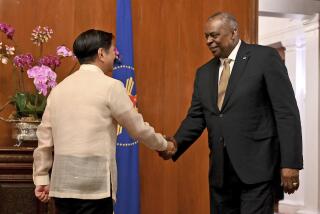Land Reform Is Back in Aquino’s Court
- Share via
Negotiations on terms for the final two years of the current military bases accord have been the central preoccupation of U.S.-Philippine relations for most of 1988. Now that agreement has been reached, it is time to refocus on the Philippines’ overriding economic and political issue: land reform.
The Philippines has one of the worst land-tenure problems still found on our planet. Most agricultural families make their living primarily on land that they do not own, as tenant farmers or agricultural laborers. Altogether, one-quarter or more of that country’s entire population consists of such landless, impoverished peasants. A substantial majority of societies with such severe land-tenure problems have carried out land reforms, either following violent revolution in which the aggrieved peasantry provided the rank-and-file of revolutionary armies (as in Russia, China and Cuba) or under non-revolutionary governments (as in Japan, Taiwan and South Korea), which sought to produce stability and prosperity in the countryside.
Japan, Taiwan and South Korea have all developed thriving agricultures following major land reforms that gave land ownership to their non-land-owning peasants, and have done so with far less land per capita than the Philippines. The Philippines, with persistent tenant farming, now produces one-half or less as much rice per acre as any of those countries, and one-third or less as much corn per acre. Likewise, the Philippines with its plantations and their hired laborers averages only three-fifths as much sugar cane per acre as Taiwan, where it is produced by small owner-operators. The land problem is principally responsible for both the growth of the New People’s Army guerrillas and the countryside’s stagnation and poverty.
Now the Philippines is on the verge of failing, for the fifth time since independence, to carry out a critically needed land-reform program. Having decided not to use her expiring “decree powers” to issue a land-reform law, President Corazon Aquino, in July, 1987, batted the ball to the new Philippines Congress in a vaguely worded executive order that did little more than reiterate the broad constitutional mandate for major land reform. In June, 1988, the Congress batted the ball back, passing a land-reform bill that, while devastatingly inadequate on its face, clearly provides Aquino the power to rescue the program.
Thus, as passed:
--The bill allows landowners to keep much greater ceiling amounts of land than under successful Asian land reforms, and combines this with apparent recognition of previous transfers of above-ceiling lands to relatives and straw men. But it gives Aquino the power to lower the ceiling.
--The bill provides a glacial pace of implementation over a 10-year period, virtually guaranteeing that most land will escape the law’s effects. But it gives Aquino the power to order a shorter period.
--The bill contemplates complex and time-consuming procedures for determining landowner compensation. But it permits Aquino to order a simpler approach for nearly all land-valuation cases.
--The bill allows “incorporated” farms--including the Aquino family’s huge sugar-cane plantation, Hacienda Luisita--to escape most of its impact. But it gives Aquino power to adopt regulations requiring corporate farm owners (including, vitally, herself) instead to transfer most of their interest to the laborers.
If the law is enforced as written, it seems likely that 250,000 acres or less will be incrementally affected and distributed to no more than 100,000 landless families. Apart from small land distributions already permitted under pre-Aquino enactments, the new program is likely to redistribute barely 1% of the Philippines’ cultivated land, with benefits to fewer than 4% of the landless.
However, if the powers provided to the executive branch are exercised, this law could still lead to a land reform affecting 6 million acres or more (over 30% of cultivated land) and benefitting more than 1.5 million landless families (at least 60% of the total). Everything now depends on the regulations to be issued under the law, and on whether Aquino chooses to personally intervene in the regulation-drafting process to avert another disastrous failure.
The United States, Japan, the World Bank and other donors can help by urging the Aquino administration to make the right decisions, and by earmarking a substantial portion of future aid (as Congress earmarked $50 million this year) for land-reform support, available only on a payment-upon-progress basis. The amounts involved pale in comparison to the projected costs of relocating America’s military bases, which may well prove useless in a crisis, if the grievances of the surrounding peasantry remain unmet.
More to Read
Sign up for Essential California
The most important California stories and recommendations in your inbox every morning.
You may occasionally receive promotional content from the Los Angeles Times.












